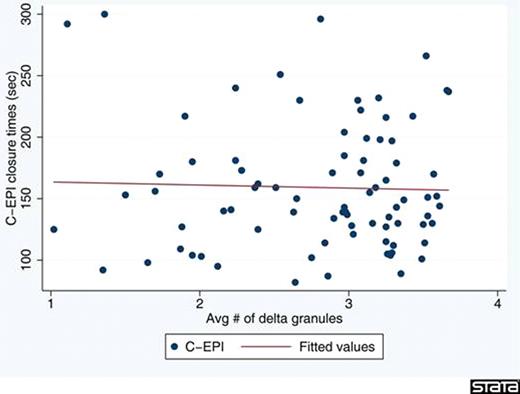Abstract
Abstract 2518
Although delta-granule platelet storage pool deficiencies (δ-PSPDs) are common disorders of platelet function, they are relatively poorly studied and described. One unknown is the relationship between δ-PSPDs and the PFA-100, a screening test originally developed for von Willebrand's disease but now widely used as a general screening test for coagulopathies. Previous studies have suggested that the PFA-100 is less effective in detecting mild platelet function disorders (which include δ-PSPDs) than more severe platelet function disorders. These studies, however, were limited by small numbers of patients with a variety of different platelet function defects. We examined PFA-100 results in a larger pediatric patient population diagnosed specifically with δ-PSPD, and determined the relationship between PFA-100 results and platelet electron microscopy (the standard for diagnosis of δ-PSPDs).
This study is a retrospective medical record review of patients 0 to 18 years of age diagnosed with δ-PSPD at Nationwide Children's Hospital between January 1, 2008 and July 31, 2010. We defined δ-PSPD as patients with an average of fewer than 3.68 delta granules per platelet. We obtained demographic data including age, sex, and family history of bleeding. Lab data was also extracted, including PFA-100 and platelet electron microscopy. We determined the percentage of δ-PSPD patients with an abnormal PFA-100. To examine the correlation between the PFA-100 results and the average number of granules per platelet we used Spearman's Rho as our non-parametric measure of dependence.
A total of 88 patients diagnosed with δ-PSPD were included in this study. Of our patient population, 35% were male, and 61% had a first degree family history of easy bruising or bleeding, while only 15% had a family history that was positive specifically for platelet function disorders. The most common symptoms on presentation were easy bruising (56%), epistaxis (39%), oral cavity bleeding (35%) and menorrhagia (30%). Eighty-one of these patients underwent PFA-100 testing, of which 41% had an abnormal CEPI value, 17% had an abnormal CADP value, and 14% had abnormal results for both PFA cartridges. We found no statistical correlation between CEPI closure time and the average number of granules per platelet (rho = 0.0315, p value = 0.7798), nor between CADP closure time and the average number of granules (rho = -0.0095, p value = 0.9328)(Figure). Additionally, the number of bleeding symptoms in each patient was not statistically correlated with CEPI closure times, CADP closure times or platelet EM. Discussion: The PFA-100, which is widely used as a screening test for suspected bleeding disorders, was abnormal in fewer than half of pediatric patients diagnosed with δ-PSPD. We found that PFA-100 results did not correlate with presence or severity of delta-granule platelet storage pool deficiencies as determined by platelet electron microscopy. When evaluating patients with suspected bleeding disorders, PFA-100 testing alone cannot be used to rule out the presence of a δ-PSPD.
Fitted plots demonstrating the lack of correlation between platelet electron microscopy and the closure time results of C-EPI and C-ADP cartridges in PFA-100 testing
Fitted plots demonstrating the lack of correlation between platelet electron microscopy and the closure time results of C-EPI and C-ADP cartridges in PFA-100 testing
No relevant conflicts of interest to declare.
Author notes
Asterisk with author names denotes non-ASH members.


